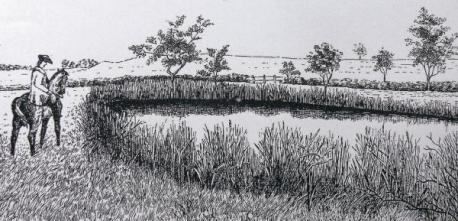 Hell’s Kettles, also known as ‘Kettles of Hell’ or ‘Devil’s Kettles’ located at Oxen-le-Hall, in the south of the parish of Darlington and have been the subject of numerous legends and superstitions.
Hell’s Kettles, also known as ‘Kettles of Hell’ or ‘Devil’s Kettles’ located at Oxen-le-Hall, in the south of the parish of Darlington and have been the subject of numerous legends and superstitions.
These three, supposedly bottomless pits are rumoured to have taken the lives of people and animals; drowned or eaten alive by the Pikes and Eels thought to infest them. Believed to contain the souls of sinners, many reports claim that the bodies of victims can be witnessed floating in the pools when clear.
Thought to have been created by a ferocious earthquake in1179, the water is believed to be hot as a result of reverberation. The sinkholes are fed by artesian water and have been designated a Site of Special Scientific Interest (SSSI) for their ability to support a hard water “fen” flora.
Locals conjectured that geese and ducks thrown in discovered subterraneous passages to the river Tees. Although Darlington is undoubtedly in the valley of the River Tees, it is its tributary, the little River Skerne that flows through the centre of the town which is truly the Darlington river. The Skerne rises in eastern County Durham to the north of Sedgefield near the former colliery village of Trimdon and flows south before joining the River Tees at Croft near Darlington, close to the site of the famous `Hell’s Kettles’ at Oxen-le-Field.
The pits once aroused the curiosity of people the length and breadth of Britain and attracted many visitors and documented their findings. One such story of a soul lost to the pits is recorded in ‘Denham Tracts’ a series of folkore collected by Michael Aislabie Denham collected from 1846-1859. The story notes that:
“Many centuries ago the owner, or occupier, of the fields where the Hell-Kettles are situated, was going to lead his hay on the feast day of St. Barnabas (June 11), and being remonstrated with on the impiety of the act by some more pious neighbour, he used the rhymes :
‘Barnaby yea! Barnaby nay! A cartload of hay, whether God will or nay”
“Instantly he, his carts and horses, were all swallowed up in the pools; where they may still be seen, on a fine day and clear water, many fathoms deep.”
Tudor chronicler William Harrison (1577) called them “three little poles, which the people call the Kettles of Hell, or ye Devil’s Kettles, as if he should seethe soules of sinfull men and women in them; they adde also that ye spirits have oft beene harde to cry and yell about them”
In History Antiquities the Parish of Darlington by Longstaffe (1854) his description of the pools quoted a twelfth century annalist thus:
“In the reign of Henry II, the earth rose high at Oxendale, in the District of Darlington, (Oxendale is now Oxney flat) in the likeness of a lofty tower, and so remained from nine in the morning until evening, when it sank don with a terrible noise, to the terror of all that heard it, and being swallowed up it left behind a deep pit”
Writer and traveller Daniel Defoe after visiting dismissed them inaccurately as `old coal pits’ despite coal never been mined in the Darlington area.
 Hell’s Kettles, also known as ‘Kettles of Hell’ or ‘Devil’s Kettles’ located at Oxen-le-Hall, in the south of the parish of Darlington and have been the subject of numerous legends and superstitions.
Hell’s Kettles, also known as ‘Kettles of Hell’ or ‘Devil’s Kettles’ located at Oxen-le-Hall, in the south of the parish of Darlington and have been the subject of numerous legends and superstitions.